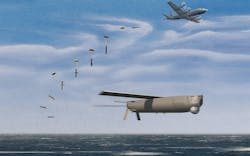Navy eyes small sonobuoy dispenser for unmanned helicopter to extend reach of anti-submarine warfare (ASW)
WASHINGTON – Northrop Grumman Corp. anti-submarine warfare (ASW) experts are testing the feasibility of the company's MQ-8B Fire Scout unmanned helicopter to expand the scope and reach of ASW operations. Kris Osborn at Warrior Maven reports. Continue reading original article
The Military & Aerospace Electronics take:
9 April 2021 -- Northrop Grumman maritime engineers have begun prototyping sonobuoy dispensers for ship-based unmanned aerial vehicles (UAVs) to search for hostile submarines over large ocean areas.
Northrop Grumman partners with sonobuoy designer Ultra Electronics to prototype a new kind of small sonobuoy dispenser that enables the Fire Scout to carry as many as 40 sonobuoys on a mission. Northrop Grumman recently tested this new prototype off the coast of California in a mock-combat scenario to assess its ability to find and discriminate targets.
The principle aim is to use unmanned aircraft to disperse many small sonobuoy dispensers across otherwise unreachable swaths of ocean to extend the Navy’s submarine-hunting reach and pool individual return signals into a centralized communications processing hub.
Related: Navy Boeing P-8 maritime patrol jet to receive anti-submarine warfare (ASW) system upgrades
John Keller, chief editor
Military & Aerospace Electronics
